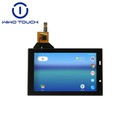Touchscreens are quite widely used in biological laboratory instruments, and can be used in almost any instrument that requires manual operation and data entry. For example:
Gene sequencer: you can set the sequencing procedure, control the sequencing process and view the sequencing results in real time through the touch screen.
Microscope: The touch screen can be used as the controller of the microscope to adjust the parameters such as focal length, brightness, contrast, etc. and display the observed images in real time.
Cell incubator: the touch screen can set parameters such as temperature, humidity, carbon dioxide concentration, monitor the culture conditions and record data.
Protein Electrophoresis Instrument: You can set the electrophoresis programme, control the electrophoresis process and view the electrophoresis results in real time through the touch screen.
Centrifuge: set the centrifugation speed, time and other parameters through the touch screen to control the centrifugation process and record the centrifugation results.
PCR instrument: you can set PCR programme, control PCR process and view PCR results in real time via touch screen.
Enzyme Labeling Instrument: You can set the testing procedure, control the testing process, and view the testing results in real time through the touch screen.
Flow cytometer: you can set the flow cytometry procedure, control the analysis process, and view the analysis results in real time through the touch screen.
The application of touch screen in biological experimental instruments is mainly reflected in the following aspects:
Experimental operation interface: the touch screen can be used as the interface of experimental operation, allowing the experimenter to intuitively and conveniently control and adjust the experimental equipment. Through the touch screen, the experimenter can directly input the experimental parameters, such as temperature, pressure, flow rate, etc.
Real-time monitoring and data display: The touch screen is equipped with a monitor that not only displays the current experimental status and data, such as temperature, pH value, etc., but also shows the experimental results in the form of charts, images or videos.
Instrument control: Many modern biological laboratory instruments are equipped with touch screen interfaces that allow the experimenter to control and operate the instrument remotely, greatly improving the convenience and efficiency of the experiment.
Instrument Calibration and Maintenance: Through the touch screen, the lab technician can also calibrate and maintain the instrument to ensure its accuracy and reliability.
Automated Processes: Touchscreens can also be used to control automated processes, for example, by automatically adjusting experimental parameters or initiating specific experimental steps through pre-set programmes.





